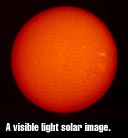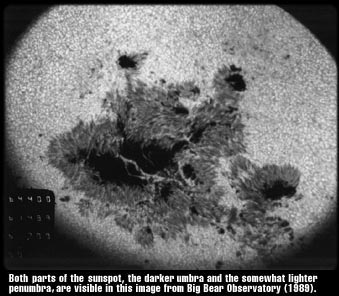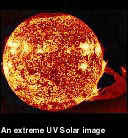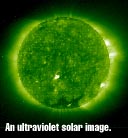|
|
|||||
|
The Sun is Still News |
|
||||
Bigger, better, different Scientists
are still looking for better ways to study the sun, and finding things the people of Galileo's time would have
marveled at. This section will look at how these new methods for examining the sun are changing our understanding
of sunspots.
We'll also explore the sunspot
cycle, and the known and possible effects sunspots have on earth. Scientists
are still looking for better ways to study the sun, and finding things the people of Galileo's time would have
marveled at. This section will look at how these new methods for examining the sun are changing our understanding
of sunspots.
We'll also explore the sunspot
cycle, and the known and possible effects sunspots have on earth. |
|
| Close-up of a typical sunspot. The curved edges of the image show the telescope's field of view. | |
| Today's telescopes The modern development of the telescope has greatly extended what astronomers can see. Today, scientists use cameras mounted on powerful telescopes to take pictures of the sun's surface magnified hundreds of times. According to David Dearborn, who is a stellar physicist at Lawrence Livermore National Laboratory when he's not studying archaeoastronomy in Peru,"The scientists in Galileo's time had instruments with less ability to see detail (less resolution). They could see clearly that there were dark regions on the sun, but they couldn't see any of the fine structure." In Galileo's time observers could only use visible light, while telescopes today operate in different wavelengths. People now use instruments that measure the light more precisely than the eye can, and using various filters and detectors, measure wavelengths, or "colors" beyond the visible: ultraviolet, infrared, and even x-rays and gamma rays. Viewing the non-visible light that the sun emits not only gives scientists new ways to examine the sun but new ways to contrast and compare results. With these new tools, scientists have begun to unravel the mysteries of sunspots. |
|
 |
||
|
Pictures of the Sun from 3 different telescopes, in different parts of the full spectrum of electromagnetic radiation (light). |
||
So what is a sunspot?
Scientists have used their bigger, better telescopes to learn more about what sunspots are. George
Fisher, a solar astronomer at the University of California, describes how scientists think of sunspots today: "A
sunspot is a dark part of the sun's surface that is cooler than the surrounding area. It turns out it is cooler
because of a strong magnetic field there that inhibits the transport of heat via convection in the sun. The magnetic field is formed below the sun's surface,
and continues out into the sun's extended outer atmosphere, or "corona."
Sunspot anatomy
 Sunspots are made up of two parts: a dark, roughly circular central
disk called the umbra, and a lighter
outer area called the penumbra. The term "umbra" means "shade" in Latin, "penumbra" means "almost
shade." A single sunspot has a finite lifetime in which it appears, grows, and gradually disappears. Of course,
we may not observe the disappearance if it happens after the sun has rotated the sunspot to the sun's opposite
side.
Sunspots are made up of two parts: a dark, roughly circular central
disk called the umbra, and a lighter
outer area called the penumbra. The term "umbra" means "shade" in Latin, "penumbra" means "almost
shade." A single sunspot has a finite lifetime in which it appears, grows, and gradually disappears. Of course,
we may not observe the disappearance if it happens after the sun has rotated the sunspot to the sun's opposite
side.
How big are sunspots?
The scale of the sun is hard to fathom. The sun is so large that about 100 earths could fit across
its diameter. It is so dense that it takes millions of years for photons produced at the core to
make their way to the sun's surface! The sun has been radiating light and heat for the past four or five billion
years. The sunspots to which this site is devoted appear as tiny spots on the sun -- but an average-sized sunspot
is as large as the earth!
|
|
|||||
|
|
|||||
|
©Copyright 2001 Regents of the University of California. |

